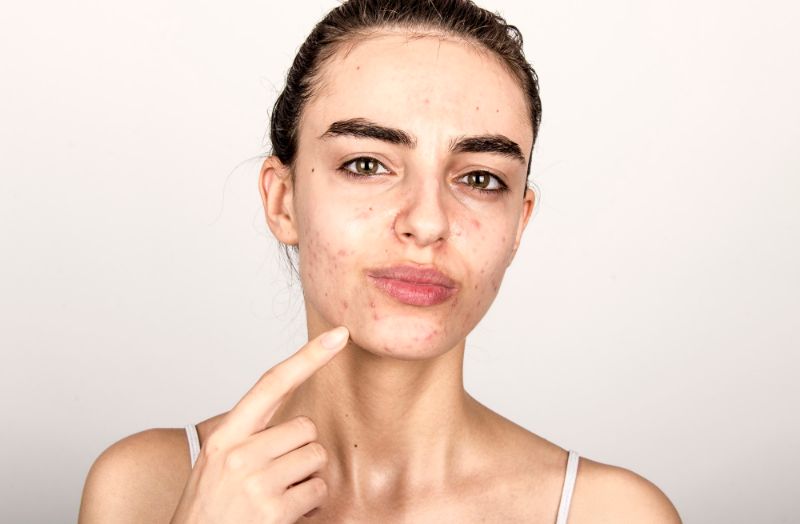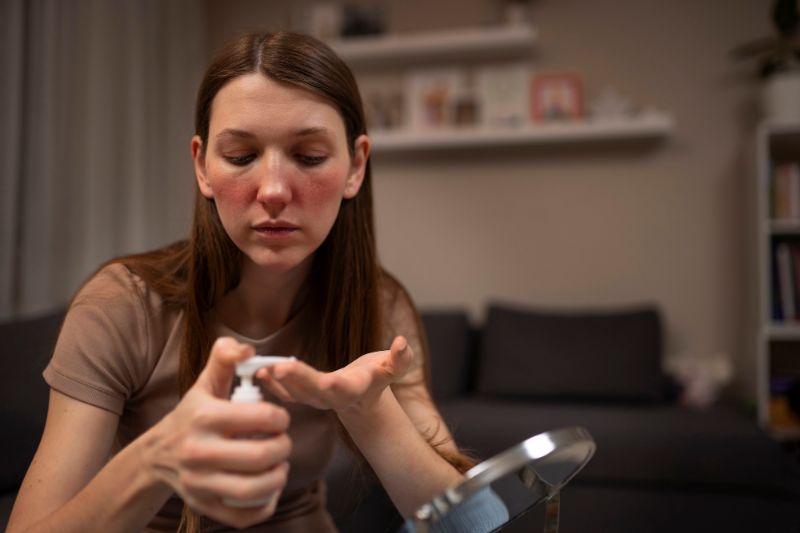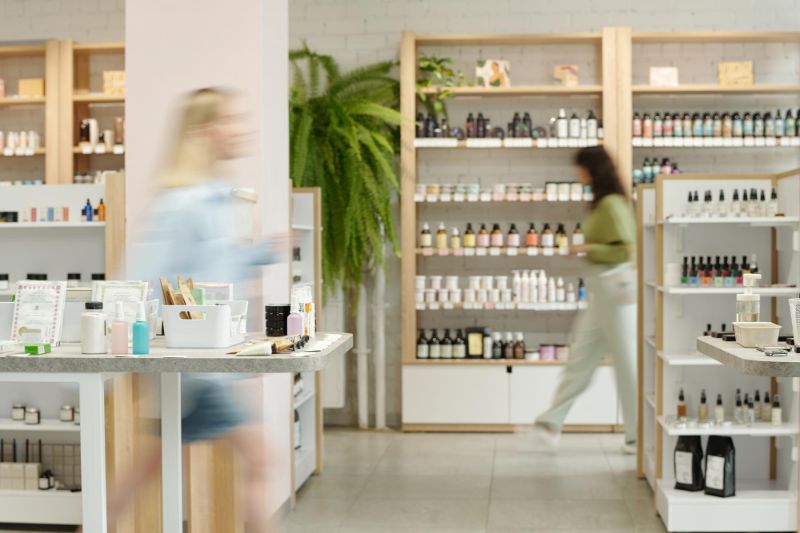Acne and rosacea are both common skin conditions that can affect individuals of all ages. While they may share some similarities in terms of appearance and symptoms, they are distinct conditions with different causes and treatment approaches. In this comprehensive guide, we will explore the differences between acne vs rosacea, including their symptoms, causes, and treatment options, to help you achieve clear and healthy skin.
Understanding Acne
Acne is a common skin condition that typically appears during adolescence but can affect people of all ages. It is distinguished by the appearance of pimples, blackheads, whiteheads, and, on rare occasions, cysts or nodules on the skin. These blemishes are most commonly found on the face, neck, chest, shoulders, and back.
Symptoms of Acne
Acne manifests itself through various symptoms, each with its own distinctive characteristics. Let’s delve into the diverse symptoms of acne to gain a deeper understanding:
- Blackheads and Whiteheads: These are among the most recognizable signs of acne. They emerge when hair follicles become obstructed by a combination of excess oil (sebum) and dead skin cells.
- Papules: These are small, red, raised bumps that develop when hair follicles become inflamed due to bacterial activity or other factors. Unlike blackheads and whiteheads, papules are inflammatory in nature and may be tender to the touch.
- Pustules: These inflamed lesions present as red, swollen bumps with a white or yellow center. Pustules can be painful and are often considered more unsightly due to the visible presence of purulent material.
- Cysts and Nodules: These deep, painful, and often large lumps form beneath the skin’s surface. Cysts are encapsulated sacs filled with pus, while nodules are solid, firm masses.

Causes of Acne
Acne can be influenced by various factors and understanding these underlying causes is essential for effective management and treatment. The following are the primary causes of acne:
- Excess Sebum Production: Overproduction of sebum, the natural oil produced by our skin, is one of the major causes of acne. When the skin produces an excessive amount of sebum, it can build up within hair follicles, promoting the formation of pimples and other acne lesions.
- Bacterial Infection (Propionibacterium acnes): Acne is closely associated with the presence of the acne-causing bacteria known as Propionibacterium acnes (P. acnes). These bacteria are normally present on the skin’s surface but can become problematic when they proliferate within hair follicles, leading to inflammation and the development of acne.
- Hormonal Changes: Hormonal fluctuations play a significant role in the development and exacerbation of acne. This is particularly evident during key life stages such as adolescence, pregnancy, and menstruation. Hormonal changes can stimulate the sebaceous glands to produce more sebum, which, in turn, contributes to the clogging of pores and the formation of acne lesions.
- Genetics: If you have a family history of acne, you may be genetically predisposed to develop the condition. Specific genes can influence how your skin responds to hormonal changes, sebum production, and the inflammatory processes associated with acne.
Understanding Rosacea
Rosacea is a chronic skin condition characterized by redness, visible blood vessels (telangiectasia), and sometimes, the development of small, pus-filled bumps (papules and pustules) on the face. Unlike acne, which primarily affects areas with a high concentration of sebaceous glands, rosacea mainly impacts the central face, including the cheeks, nose, forehead, and chin. It typically appears in adulthood and tends to worsen over time if left untreated.
Symptoms of Rosacea
Rosacea can manifest through a range of symptoms, each presenting unique challenges for those affected. For a comprehensive understanding of this condition, let’s further explore the symptoms of rosacea:
- Facial Redness: Perhaps the most recognizable and pervasive symptom of rosacea is persistent facial redness. This redness often resembles a blush or sunburn, covering the central face, including the cheeks, nose, forehead, and chin.
- Visible Blood Vessels: Small, visible blood vessels on the face, known as telangiectasia, are a common feature of rosacea. These dilated blood vessels create a network of fine, red lines on the skin’s surface, contributing to the overall redness and often giving the appearance of a “spider web” pattern.
- Bumps and Pimples: Rosacea can lead to the development of small, red papules and pustules on the face. These bumps can be easily mistaken for acne lesions, but they have distinct differences. Rosacea papules and pustules are typically smaller and more uniformly red compared to the whiteheads and blackheads commonly associated with acne.
- Eye Irritation: Ocular rosacea is a subtype of the condition that affects the eyes. Individuals with ocular rosacea may experience a range of eye-related symptoms, including dryness, itching, burning, and even vision problems.

Causes of Rosacea
Although the exact cause of rosacea is unknown, several factors are thought to contribute to its development, including:
- Genetics: If you have family members, especially parents or siblings, with a history of rosacea, your risk of developing the condition is higher. Genetics play a significant role in rosacea susceptibility, so knowing your family’s medical history can help assess your risk.
- Abnormal Blood Vessels: Rosacea’s redness is linked to irregular blood vessels in facial skin. These vessels can dilate, leading to persistent redness and visible blood vessels called telangiectasia, which are characteristic of rosacea.
- Trigger Factors: Various triggers, like spicy foods, alcohol, hot drinks, sunlight, and stress, can worsen rosacea symptoms. Identifying and avoiding these triggers is crucial for managing and minimizing the impact of rosacea on your skin and overall well-being.
Differences: Acne vs Rosacea
While acne and rosacea can share some symptoms, there are key differences that can help distinguish between the two skin condition:
- Location: Acne commonly appears on the face, chest, shoulders, and back, while rosacea primarily affects the central face, including the cheeks, nose, forehead, and chin.
- Lesion Types: Acne often includes blackheads, whiteheads, and cysts, while rosacea features redness, visible blood vessels, and occasional papules and pustules.
- Age of Onset: Acne typically starts during adolescence, while rosacea typically develops in adulthood, usually after the age of 30.
- Triggers: Rosacea is often triggered by certain factors like alcohol, spicy foods, and sunlight, while acne is less influenced by external triggers.

Treatment Options
Both acne and rosacea can be effectively managed with various treatment approaches, but the choice of treatment depends on the specific condition and its severity.
Treatment for Acne
When it comes to managing acne, there are several effective treatment options to consider:
- Topical Treatments: Benzoyl peroxide, salicylic acid, and retinoids are just a few topical medications and over-the-counter products that can help unclog pores and soothe inflammation.
- Oral Medications: Antibiotics, oral contraceptives, and oral isotretinoin may be prescribed for severe or persistent acne.
- Lifestyle Changes: Maintaining good skincare practices, avoiding squeezing or picking at pimples, and managing stress can help control acne.
Treatment for Rosacea
When addressing the management of rosacea, various treatment approaches are available to alleviate its symptoms:
- Topical Medications: Prescription topical medications such as metronidazole, azelaic acid, and brimonidine can reduce redness and inflammation associated with rosacea.
- Oral Medications: In some cases, oral antibiotics like doxycycline or isotretinoin may be prescribed to manage symptoms.
- Lifestyle Modifications: Identifying and avoiding triggers is crucial in managing rosacea. Sun protection, gentle skincare, and using a daily moisturizer can also help.
- Laser Therapy: Laser or light-based treatments can effectively reduce redness and visible blood vessels associated with rosacea.
Final Thoughts
In summary, distinguishing between acne and rosacea is essential for effective management. Acne, prevalent among adolescents, manifests as various blemishes, while rosacea mainly affects adults and leads to facial redness and visible blood vessels. Both conditions can have genetic links, and treatment options include topical medications, oral drugs, lifestyle adjustments, and laser therapy. Seeking professional guidance and proactive skincare can help individuals achieve clearer, healthier skin and improved self-confidence when dealing with acne or rosacea.
FAQs
- Are acne and rosacea the same thing?
No, acne and rosacea are distinct skin conditions with different causes, symptoms, and treatments.
- Can I inherit acne from my family?
Yes, a family history of acne can increase your susceptibility to the condition due to genetic factors.
- Is rosacea hereditary?
Yes, if you have family members with rosacea, especially parents or siblings, your risk of developing it is higher due to genetic predisposition.
- Can acne and rosacea coexist in the same individual?
Yes, it is possible for an individual to have both acne and rosacea simultaneously.
